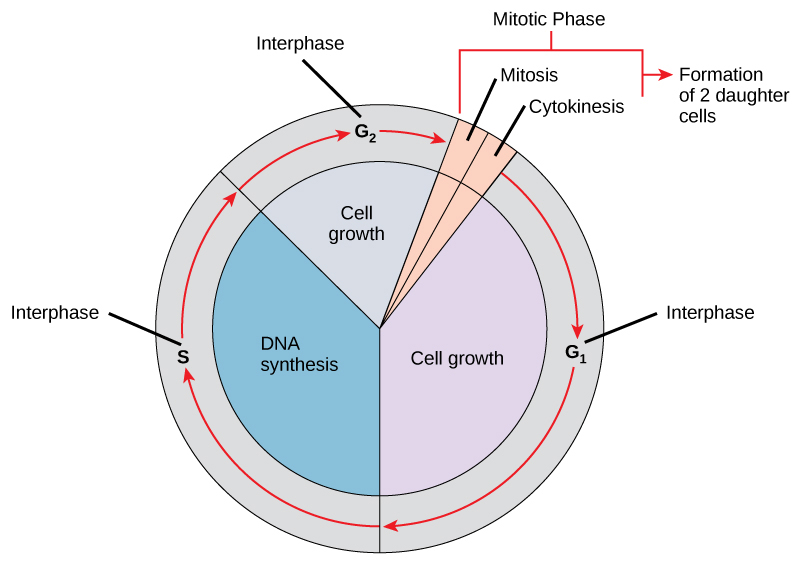Chapter 3 Neoplasia
Review of Cell Cycling, DNA duplication, Cell Differentiation and Errors that can lead to Cancer
More pictures coming soon!
Zoë Soon
Review of Cell Cycling and DNA duplication
Cell cycling in humans begins right away, starting with a fertilized egg. Undoubtedly you don’t remember when you were this young, however, your first act as a fertilized egg was to grow larger in size and then get divide from 1 cell into 2 identical cells. This process is termed cell cycling. During cell cycling a cell becomes larger, duplicates its organelles and DNA and then divides into two identical daughter cells. This process of cell duplication is also sometimes called cell division, or cell proliferation or simply mitosis.
The steps of cell cycling are all equally important. The process begins in Interphase and there are three distinct stages within Interphase: G1, S and G2. In G1, the cell is growing in size and is duplicating its organelles. In S phase, DNA duplication occurs and in G2, the cell grows a bit more. After interphase is complete, the cell enters Mitosis. Within mitosis the enlarged cell divides into two cells, with half of its organelles and one set of DNA ending up in each daughter cell.
Review of Cell Differentiation
As the fertilized egg grows, and repeatedly goes through cell cycling, a ball of identical cells called a blastocyst is created. At this point in time cells begin to mature and differentiate slightly to form 3 unique cell lineages (endoderm, mesoderm, and ectoderm). Within each of these cell types, cells continue to go through cell cycling and the embryo gets larger and larger in total size. Eventually these cells will become even further differentiated forming lineages for all 200 cell types of the human body (e.g. epithelial cells, cardiomyocytes, hepatocytes, etc.). Organs will form with unique sets of cell types becoming more and more functional. Wtihin each organ and tissue, some daughter cells (termed stem cells) continue to cell cycle, producing more cells, allowing the embryo to get larger, while other daughter cells exit the cell cycle and full mature or differentiate. These fully mature cells can no longer cell cycle and divide, and instead express specific proteins and enzymes to become more and more functional. This process continues through all stages of development from embryo to fetus to newborn to child to teenager. Even as a full-size adult, many tissues contain stem cells that divide in order to allow for the replacement of mature cells that get old and die. However most cells have exited the cell cycle and have fully differentiated to ensure that each organ and tissue is functional.
Cellular Review of Cellular proliferation and differentiation begin with a fertilized egg.
During embryogenesis, the fertilized egg undergoes mitosis, leading to cell division.
Cells differentiate into various types, such as epithelial, connective, muscle, and neural tissue.
Stem cells undergo mitosis to produce daughter cells, which may differentiate into functional cells.
During mitosis, organelles double, and DNA duplication occurs during the S phase of the cell cycle.
Enzymes check DNA for errors during duplication, triggering apoptosis if mutations are found.
Telomeres, end caps of chromosomes, shorten with each cell division, acting as a safety net to limit division.
Telomere shortening helps prevent excessive divisions, reducing the risk of mutations and cancer development.
Apoptosis is triggered if telomeres reach a certain length, preventing further cell division and potential cancerous growth

DNA mutations and Cancer
Unfortunately during S phase, as DNA is duplicated there is a chance for errors in sequencing together the correct strands of nucleotides. Luckily there are several enzymes that check the DNA for errors during duplication and will trigger apoptosis if mutations are found that can not be fixed. It is known that mutations that occur in DNA (depending on the location) can cause cancer. It is also known that inevitably DNA errors do occur during duplication just due to the shear number of times DNA is duplicated, not to mention the number of nucleotides within each of the 23 pairs of chromosomes. It may seem obvious that the more DNA duplication events there are, the more risk there is for DNA errors to occur. Therefore a person’s age becomes a risk factor for DNA mutations (and the possibility that these mutations may give rise to cancer). One can also imagine that if any of the enzymes responsible for checking DNA for errors in S phase is damaged or mutated or absent, that again person has an increased risk of accumulating mutations and therefore susceptibility to cancer.
Role of Telomeres and Telomerase in Cancer
Telomeres, the end caps of chromosomes, which are maintained through childhood and adolescence through the enzymatic action of telomerase which continues to add telomere to the ends of chromosome. Telomerase is inactivated in adulthood and the telomeres begin to shorten with each cell division, acting as a safety net to limit division. At a certain length, a critical point is reached, and the cell becomes dormant or dies. This telomere shortening helps prevent excessive divisions, reducing the risk of mutations and cancer development. Additionally, at a certain age the cell has likely become less functional or dysfunctional, potentially accumulating waste products or abnormalities and it would become detrimental to the body if it wasn’t inactivated or removed. In tissue that is regenerative, old cells can be replaced through the division of tissue-specific stem cells. In cells that die when telomeres reach a certain length, apoptosis is triggered and macrophages engulf and recycle their components. Interestingly it has been found that in 90% of cancers, telomerase has been re-activated in the cancerous cells (which helps them to become immortal – continually adding telomere length and thereby permitting continual cell cycling).
Media Attributions
- Control of the Cell Cycle © Charles Molnar and Jane Gair is licensed under a CC BY (Attribution) license

